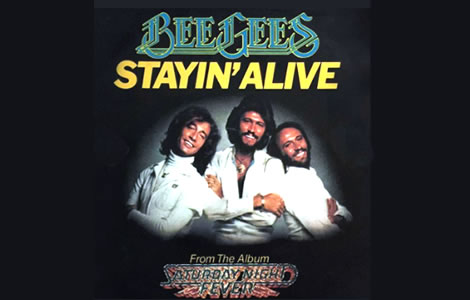
The late 1970s were a time of seismic shifts in popular music, with disco music rising to prominence as the soundtrack of a generation. At the heart of this explosion was “Stayin’ Alive” by the Bee Gees.

Atrack that not only became a defining anthem of the era but also helped launch a cultural phenomenon that continues to resonate to this day.
The Genesis of “Stayin’ Alive” and Its Role in Saturday Night Fever
“Stayin’ Alive” was born out of the Bee Gees’ collaboration with producer Robert Stigwood, who was also managing their careers.
The song was initially conceived for the soundtrack of the film Saturday Night Fever, a project that would become synonymous with the disco era.
The Bee Gees—comprising brothers Barry, Robin, and Maurice Gibb—had been experimenting with a new sound that combined their signature harmonies with the rhythmic grooves and pulsating bass lines that characterized disco music.
The recording sessions for “Stayin’ Alive” took place at Château d’Hérouville in France and Criteria Studios in Miami.
The song’s signature bass line was created by Barry Gibb, while the driving beat was constructed using a drum loop taken from the Bee Gees’ earlier track “Night Fever.”
This innovative use of looping was a precursor to many of the production techniques that would later become standard in dance music.
Lyrically, “Stayin’ Alive” captured the gritty resilience and defiance of life in the urban jungle, themes that mirrored the struggles of Tony Manero, the protagonist of Saturday Night Fever, played by John Travolta.
The song’s opening lines—”Well, you can tell by the way I use my walk, I’m a woman’s man, no time to talk”—immediately set the tone for both the movie and the disco movement it epitomized.
The Impact of “Stayin’ Alive” on the Disco Era
When Saturday Night Fever was released in December 1977, it became an instant sensation, catapulting John Travolta to stardom and turning the Bee Gees into global icons.
The film’s soundtrack, which featured multiple tracks by the Bee Gees, including “Stayin’ Alive,” quickly climbed to the top of the charts and remained there for an astonishing 24 weeks.
“Stayin’ Alive” itself became the anthem of the disco movement. Its infectious rhythm, coupled with the Bee Gees’ falsetto harmonies, made it an irresistible dance floor filler.
The song’s popularity was further amplified by its association with the film, as scenes of Travolta strutting down the streets of Brooklyn to the beat of “Stayin’ Alive” became iconic moments in cinematic history.
Chart Success and Global Dominance
The success of “Stayin’ Alive” was not confined to the United States, where it topped the Billboard Hot 100 for four consecutive weeks.
The song also dominated charts across the globe, reaching number one in the UK, Canada, Australia, and numerous European countries, including France, Germany, and Italy.
In the UK, the track spent two weeks at the top of the charts, while in Australia, it became one of the highest-selling singles of 1978.
In Asia, “Stayin’ Alive” resonated strongly in Japan, where it climbed to the upper echelons of the Oricon Singles Chart.
The song’s success in such diverse markets underscored the universal appeal of the Bee Gees’ music and the widespread influence of the disco movement.
Cultural Legacy and Radio Airplay
“Stayin’ Alive” has transcended its origins as a disco anthem to become one of the most enduring songs in popular music history.
Its longevity is evident in its continued prominence on radio playlists worldwide. Decades after its release, the song remains a staple of classic hits and oldies stations, as well as a perennial favorite at parties and events.
The cultural impact of “Stayin’ Alive” extends beyond the music world. The song has been referenced and parodied in countless films, television shows, and commercials, further cementing its place in the collective consciousness.
In 2004, it was ranked number 189 on Rolling Stone’s list of the “500 Greatest Songs of All Time,” a testament to its lasting influence.
The Enduring Appeal of “Stayin’ Alive”
The success of “Stayin’ Alive” and the Saturday Night Fever soundtrack helped solidify the Bee Gees’ position as one of the most successful musical acts of all time
The song’s infectious groove, memorable lyrics, and the brothers’ distinctive falsettos captured the essence of an era and provided the soundtrack to a cultural revolution.
Even as disco eventually faded from the mainstream, “Stayin’ Alive” continued to thrive, becoming a symbol of the era’s exuberance and excess.
Its ability to evoke the spirit of the late 1970s, coupled with its timeless appeal, has ensured that “Stayin’ Alive” remains as relevant today as it was over four decades ago.
In a world where musical trends come and go, “Stayin’ Alive” stands as a beacon of the disco era’s enduring legacy—a song that not only defined a generation but also continues to inspire new ones.
Whether played in a club, on the radio, or in a movie, the unmistakable beat of “Stayin’ Alive” will forever be a reminder of the power of music to unite, uplift, and transcend time.
